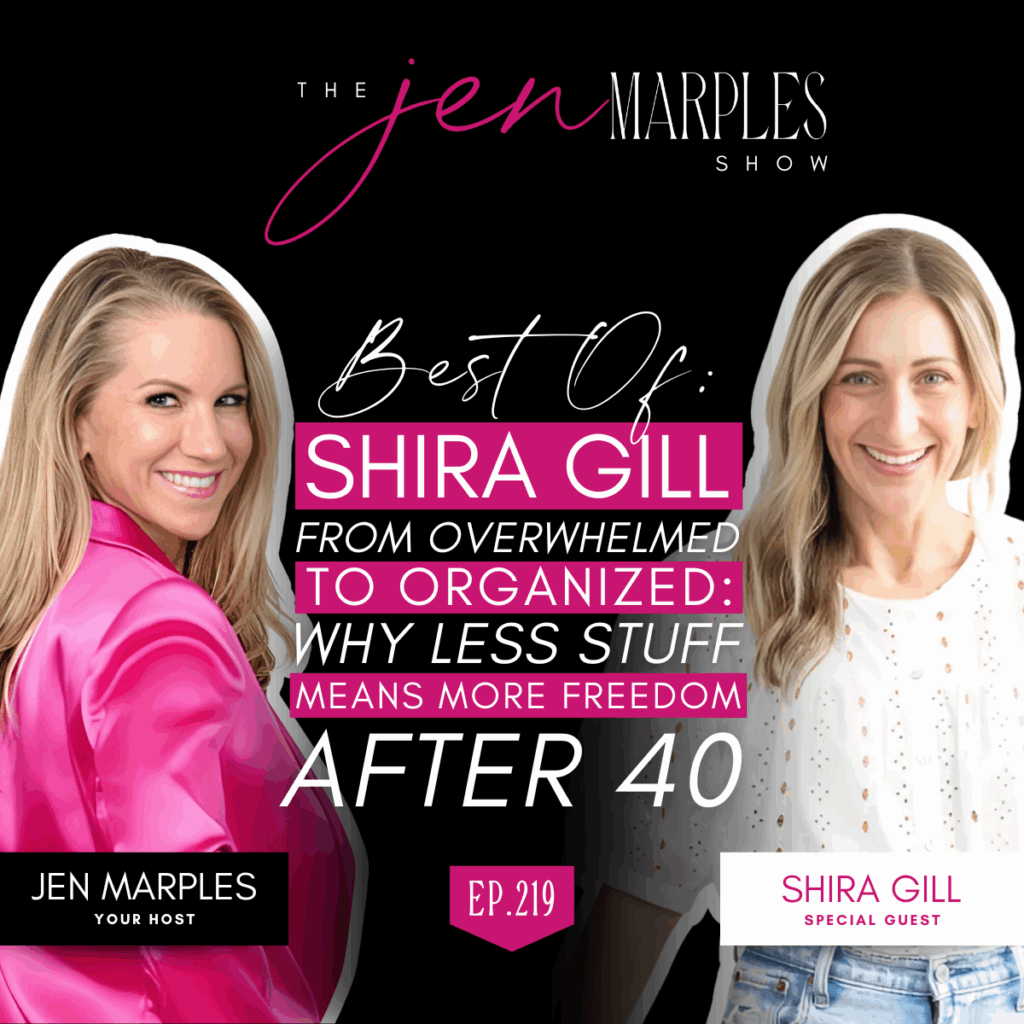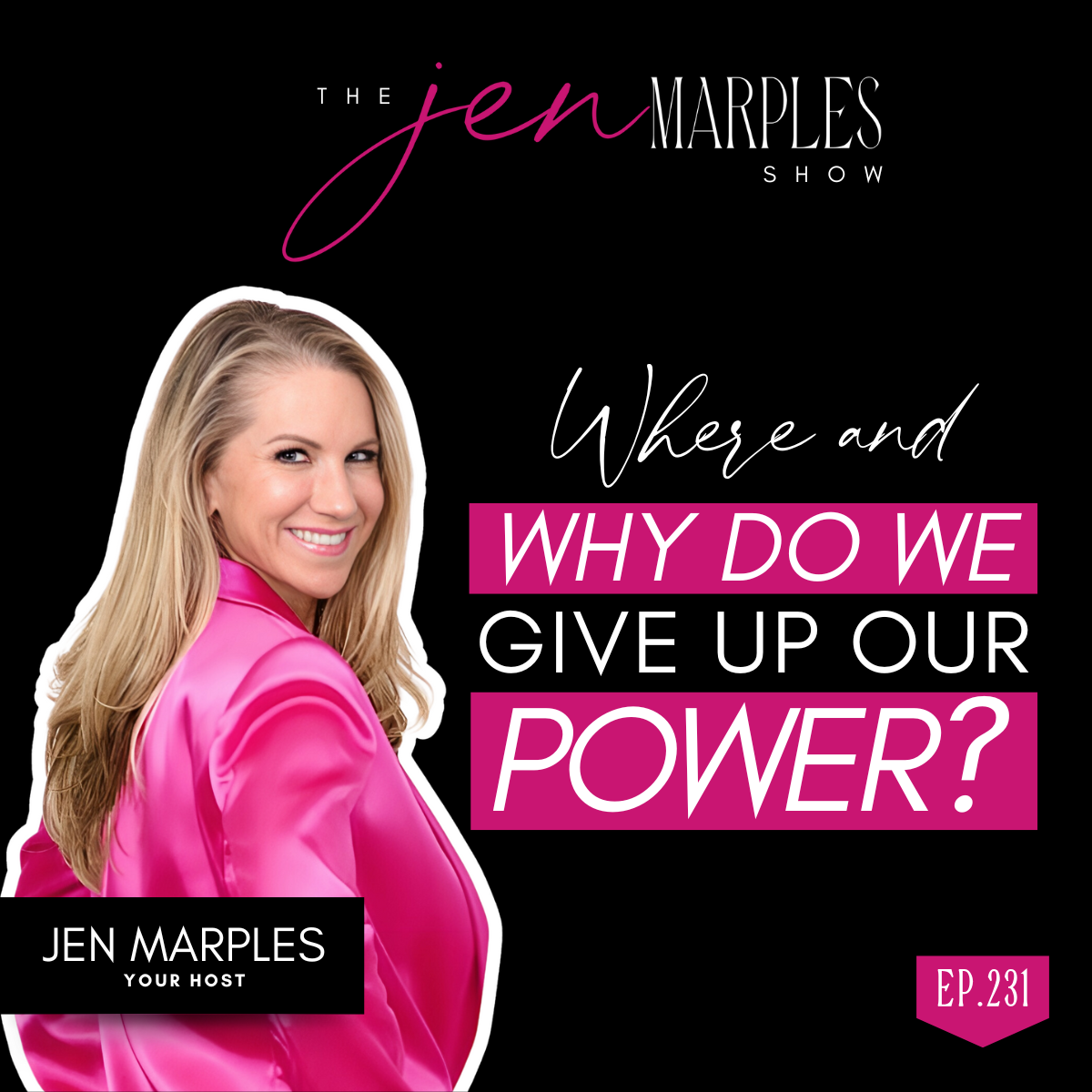
I’m replaying this Best Of episode with the incredible organizing expert Shira Gill and it will change your life! Shira went from being laid off at eight months pregnant to building an organizing empire – all because she solved a problem people desperately wanted to pay for. Shira Gill drops truth bombs about how clutter is literally bombarding our brains with excessive stimuli and why our chaotic environments are making us anxious and depressed.
If you’ve ever felt overwhelmed by your stuff, stressed walking into certain rooms, or like you can’t think straight in your own space, this conversation will change everything. Shira shares why less stuff equals more money, time, and freedom – plus her game-changing “15-minute win” that will transform your home one micro-space at a time. And wait until you hear about the woman who went from 300 pairs of shoes to living her best life in an Airstream trailer!
Key Takeaways:
- The clutter-mental health connection: Why your messy environment is literally making your brain work harder
- The 15-minute win: How to transform your entire home without feeling overwhelmed
- Start with your why: The motivation trick that makes letting go actually exciting
- The midlife declutter advantage:How downsizing can unlock your most adventurous chapter yet
- When less becomes more: Real stories of women who chose freedom over stuff and are living their dreams
Why Your Cluttered Home Is Making You Anxious (And How to Fix It in 15 Minutes) with Shira Gill
You walk into your living room and immediately feel your shoulders tense up. The stack of magazines on the coffee table seems to mock you. The overflowing basket of laundry in the corner makes your chest tight. Sound familiar?
Here’s what most people don’t realize: your cluttered space is literally rewiring your brain for stress. Research shows that messy environments bombard your mind with excessive stimuli, forcing your brain to work overtime just to process what you’re seeing. No wonder you feel exhausted before you even start your day.
This article breaks down insights from home organizing expert Shira Gill, who has helped thousands of overwhelmed people transform their chaotic spaces into calm sanctuaries. If you’re a busy person drowning in stuff and struggling to find breathing room in your life, these strategies will show you how to reclaim control without spending your entire weekend organizing.
The best part? You don’t need to become a minimalist monk or throw away everything you own. You just need a smarter approach.
Start Here
Are you ready for this transformation?
Before you dive in, ask yourself: Are you tired of feeling overwhelmed every time you walk into your home? Do you find yourself avoiding certain rooms because they stress you out? If you answered yes, then you’re ready to make a change.
This approach works best if you’re willing to be honest about what truly matters to you and what doesn’t. You’ll need to challenge some beliefs about why you keep certain items and be open to letting go of things that no longer serve you.
What you’ll need:
- 15 minutes of uninterrupted time
- Three containers or bags (keep, donate, trash)
- A timer
- A clear vision of what you want more of in your life
- The willingness to start small and build momentum
Step-by-Step Guide with Shira Gill
Step 1: Define Your “Why” Before You Touch Anything
Most people grab a trash bag and start throwing things away without any clear direction. This leads to decision fatigue within minutes and often results in giving up before you make real progress. The secret isn’t starting with the stuff – it’s starting with your vision. When you have a compelling reason for creating space, every decision becomes easier because you’re not just getting rid of things, you’re making room for what matters most. Maybe you want to host dinner parties without feeling embarrassed about your dining room. Perhaps you dream of traveling more and want to rent out your home to fund adventures. Or you simply crave the mental peace that comes with walking into a calm, organized space.
Key takeaway: Your motivation is your fuel. Without it, you’ll run out of steam quickly.
Action steps:
- Write down what you want to create more space for in your life
- Identify what you want less of (cleaning time, stress, visual chaos)
- Keep this vision visible during your decluttering sessions
- When you get stuck on an item, ask: “Does keeping this support my vision?”
Step 2: Master the 15-Minute Win Strategy
The biggest mistake people make is trying to declutter their entire home in one weekend marathon session. This approach is overwhelming, exhausting, and often leads to burnout before you see real results. The 15-minute win strategy flips this on its head by focusing on one tiny area at a time. You pick a micro-space (like the coat closet or one kitchen drawer), set a timer for exactly 15 minutes, and work until it rings. This method works because it’s manageable enough that you can’t talk yourself out of it, yet long enough to see meaningful progress. The key is choosing areas small enough that you can completely finish them in your time limit, giving you an immediate sense of accomplishment that motivates you to tackle the next space.
Key takeaway: Small, consistent wins build momentum better than sporadic big efforts.
Action steps:
- Choose one micro-area you can complete in 15 minutes
- Set a timer and work only until it goes off
- Put everything back nicely before you stop
- Celebrate your win and plan tomorrow’s 15-minute target
- Stay in one room until it’s completely done before moving to another
Step 3: Understand the Psychology Behind Your Clutter
Your stuff tells a story about your emotional state, and ignoring this connection is why most organizing attempts fail. We live in a culture that constantly tells us we need more to be happy, and many people use shopping as a way to cope with loneliness, boredom, or feelings of emptiness. That pile of clothes with tags still on? It might represent hope for a different version of yourself. The stack of books you never read? Perhaps they make you feel smarter or more prepared. The key insight is that clutter often serves an emotional function, even when it creates chaos in your physical space. Until you address why you accumulate things in the first place, you’ll keep replacing old clutter with new clutter. This is why successful decluttering requires both practical skills and emotional awareness.
Key takeaway: Clutter is often a symptom of deeper needs that aren’t being met in healthy ways.
Action steps:
- Notice what emotions come up when you consider letting go of items
- Ask yourself what need each category of clutter is trying to meet
- Find healthier ways to meet those emotional needs
- Practice self-compassion when guilt or shame arise during the process
- Consider working with a counselor if decluttering brings up intense emotions
Step 4: Create Simple Systems That Actually Stick
Most people think organization means color-coded containers and alphabetized everything, but this complexity is exactly why systems fail. The best organizational systems are so simple that you can maintain them even when you’re tired, stressed, or in a hurry. The secret is giving every frequently used item a designated home and making it easier to put things away properly than to dump them randomly. This might mean placing a small dish by your front door for keys, installing hooks for dog leashes, or designating one specific spot for incoming mail. The goal isn’t perfection – it’s creating habits that prevent chaos from building up in the first place. When your systems are simple and logical, other family members can follow them too, multiplying your efforts.
Key takeaway: Simple systems you actually use beat complex systems you abandon.
Action steps:
- Identify items you lose or misplace regularly
- Create a specific home for each of these items
- Make the system as easy as possible to maintain
- Focus on frequently used items first
- Test your system for a week before adding complexity
Step 5: Handle Resistant Family Members With Strategy, Not Force
Trying to change other people’s habits is a recipe for frustration and family conflict. The most effective approach is to focus entirely on your own belongings first, creating visible improvements that speak louder than any nagging ever could. When family members see how much better shared spaces look and function, they often become curious about participating. The key is having a values-based conversation about how you want your home to function rather than lecturing about cleanliness. Maybe you both value being able to host friends comfortably, or you want your kids to have space to play safely. Find the common ground and let that shared vision guide the conversation. For areas where compromise isn’t possible, consider creating designated spaces where different standards can coexist peacefully.
Key takeaway: Lead by example and focus on shared values rather than trying to impose your preferences.
Action steps:
- Start by organizing only your personal belongings
- Have conversations about how you want your home to function together
- Create systems but let others choose whether to follow them
- Consider designating “messy zones” and “clean zones” if needed
- Celebrate small improvements from family members without pushing for more
Step 6: Recognize When Less Becomes More
The counterintuitive truth about possessions is that owning fewer things often leads to having more of what you actually want: more money (less spent on stuff and storage), more time (less cleaning and organizing), and more mental space (less visual chaos to process). This shift in perspective changes everything about how you make purchasing decisions and evaluate what to keep. Instead of asking “Might I need this someday?” you start asking “Does this add genuine value to my current life?” The magic happens when you realize that every item you don’t buy or keep is time and energy you get back for the things that truly matter. This isn’t about deprivation – it’s about being intentional with your choices so your possessions support your best life instead of weighing it down.
Key takeaway: Strategic subtraction creates more room for what matters most.
Action steps:
- Track how much time you spend managing your possessions each week
- Calculate the real cost of storage, maintenance, and organization
- Practice the “one in, one out” rule for new purchases
- Focus on quality over quantity in future buying decisions
- Notice how you feel in spaces with less visual clutter
Conclusion
Your home should be your sanctuary, not your source of stress. The connection between cluttered spaces and anxious minds isn’t just in your head – it’s backed by research and experienced by millions of overwhelmed people every day.
The solution isn’t about achieving magazine-perfect rooms or becoming an extreme minimalist. It’s about being intentional with your belongings so they support the life you want to live instead of holding you back from it.
Here’s your action plan to get started:
- Define your vision – Write down what you want more space for in your life
- Start your first 15-minute win – Choose one small area and set a timer today
- Examine your emotional patterns – Notice what drives you to accumulate things
- Create one simple system – Give frequently used items designated homes
- Focus on your own stuff first – Lead by example rather than trying to change others
- Embrace the “less is more” mindset – Every item you don’t keep is freedom you gain back
Remember, this isn’t about perfection. It’s about progress. Each 15-minute win builds momentum toward a home that supports your peace of mind instead of undermining it. Start small, be consistent, and watch how quickly your space – and your stress levels – transform.
The best time to start was yesterday. The second best time is right now. Set your timer and begin.
Learn more about Jen Marples at https://www.jenmarples.com
Want to work with Jen? Book a complimentary 20-minute call HERE.
Follow Jen @jenmarples on Instagram, LinkedIn, TikTok and YouTube
Subscribe to Jen’s Newsletter
Unedited AI Transcript Here
CONNECT WITH SHIRA GILL:
Shira Gill on Instagram
Shira Gill Website




